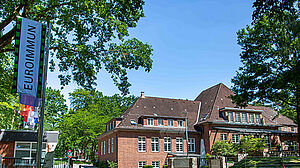The production of antigens in sufficient amounts and of the desired quality is often the critical step in the development of a new test system. In particular, the purification is often difficult and causes delays in the development process. This may be due to different reasons:
- The antigen is located in the cell membrane: To eliminate the molecule from the membrane, aggressive methods are often required which may destroy the antigen.
- The antigen must be in its native, three-dimensional form. If the antibodies to be detected bind to conformational epitopes of the antigen, it needs to be purified in its native state, a procedure which is very complicated and complex.
In these cases, a genetic method for the production of antigens is by far quicker. In the RC-IIFT method, the antigen-coding DNA sequence is inserted into a DNA molecule (plasmid) which is afterwards introduced into suitable host cells. The cells express the antigen molecule and can thus be immediately used as a substrate in the immunofluorescence test. Using this method, test systems with new antigens can be produced in a short time.
The following EUROIMMUN test systems are based on the RC-IIFT method:
| Recombinant Cell IIFT for the detection of antibodies against: |
|---|
| Skin antigens: desmoglein 1 and 3, BP230, collagen VII, envoplakin* |
| Nephropathy-associated antigens: phospholipase A2 receptors (PLA2R) |
| Neuronal antigens: glutamate receptors of type NMDA, type AMPA*, VGKC, GABAB receptor, aquaporin-4, glycine receptor **, DPPX, DNER |
| Further antigens: pancreas antigens rPAg1 (CUZD1) and rPAg2 (GP2), glutamate decarboxylase (GAD65), Crimean-Congo fever virus |
*currently not sold as IVD in the EU **under development




















